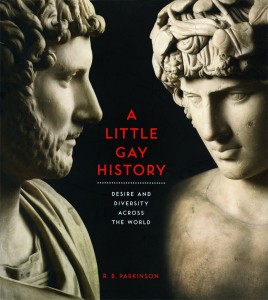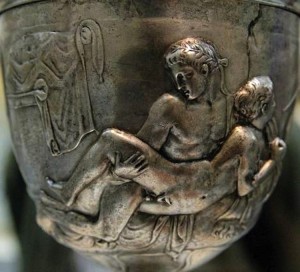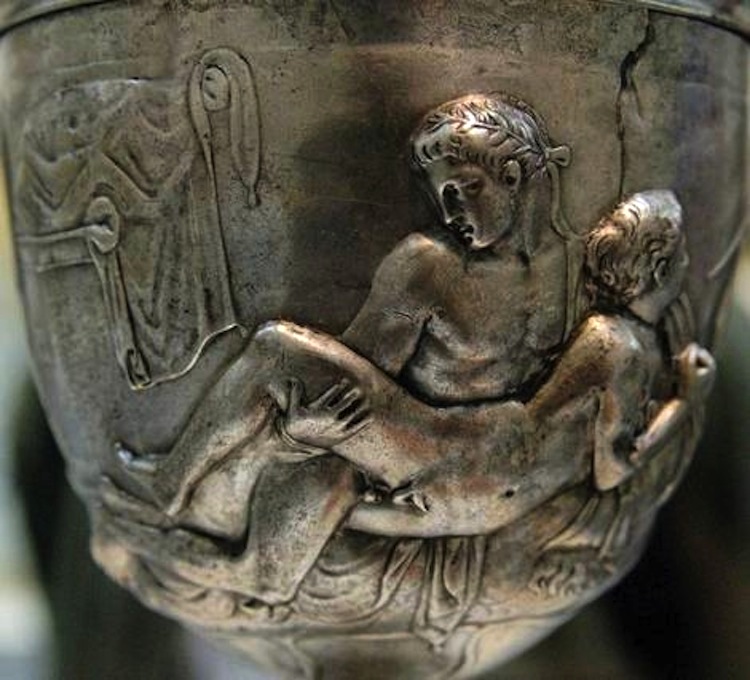 A Little Gay History: Desire and Diversity across the World
A Little Gay History: Desire and Diversity across the World
by R. B. Parkinson
Columbia. 128 pages, $19.95
Editor’s Note: This review is an edited transcript of a video presentation that can be viewed on the GLR blog at www.GLReview.org.
THE PROJECT that finally became this book began as a web trail from the British Museum. It is a pictorial sampling of items from that museum across centuries and cultures of mostly visual representations of same-sex desire and gender ambiguity. Each depiction has a paragraph or two of explanation, much as you would find on the plaques that accompany art works in a museum exhibit. The items are arranged in roughly chronological order.
The book starts with its only extended piece of prose: an introduction that, in explaining the choice of the word “gay” for the title, reviews the work that has been done on sexual identity over the last 150 years. It cautions, as historians such as Foucault have done for almost half a century now, against viewing past cultures through the gender constructions of our own time. In viewing these various artifacts, in other words, “it is impossible to have an infallible ‘gaydar’ across other cultures and periods.” The introduction also reminds the reader, more generally, that “art is never simply a reflection of social reality.” Artists, whether great painters or simple potters, craft their work in accord with particular personal ideas. Their work can never be read as a transparent window on or reflection of the culture in which they were produced.

Still, Parkinson argues, specialized histories such as this “can offer a valuable alternative to the official histories that nation states have often produced—and still produce—for themselves.” More specifically, he expresses the hope that this book “will not only illustrate some aspects of lesbian, gay, bisexual and transgender history, but will also show the diverse material forms that such history takes.”
And with that we are off to the items on display. Parkinson starts with a small sculpture found near Bethlehem that dates back almost 11,000 years. It depicts two persons embracing. “Nothing makes it absolutely certain that it is a man and a woman,” Parkinson observes. “The genders of the figures are unmarked.” “We need not assume that ‘heterosexuality’ or the modern nuclear family as we know them are the default options for any society, ancient or modern,” he concludes. So this collection begins in ambiguity.
That remains one of its main themes. We see a clay relief of the goddess Ishtar from Mesopotamia with the claws of a male bird of prey and are told that in some instances she was even depicted with a beard—though we don’t get to see an example of that. There is also a statue of the male god Shiva from 12th-century India in which the figure wears one man’s earring and one woman’s earring.
As Parkinson explains in the preface, “desire and identity are not limited to sexual activity, but inevitably depictions of sex are the most unambiguous historical records that we have of such desire.” As a result, there are also plenty of examples of same-sex activity in this exhibit, most of them involving men. Some are mild, such as an early 19th-century print by Japanese artist Kitagawa Utamaro of one warrior tenderly holding the hand of his male page while another warrior looks less tenderly at a woman.
One of the more remarkable of the depictions of same-sex desire comes from the first century C.E., a silver drinking cup supposedly found near Jerusalem, now known as the Warren Cup, because it was once owned by gay American art collector Edward Perry Warren. The book doesn’t offer us much in the way of an analysis of such a striking item, however. Rather, it gives us its history and a few generalizations about sexuality in the Roman Empire, and then moves on to the next item. At such times, this book gets a little frustrating. Unlike an exhibition catalog, there are no essays to offer detailed scholarly discussions.
When we get to the 20th century in the last few pages, the examples are less striking for being more familiar. We see, for example, three figurines sculpted by German ceramicist Hedwig Marquardt in 1924, two of them women. But while Marquardt herself may have been a lesbian, it’s hard to see what her sexuality had to do with these works.
There is nothing in this book that is intended to change our way of seeing sexuality and identity through the ages. Rather, it provides us with several examples of how it has been depicted, reminding us that no matter how natural our desires may seem to us, depictions of it from other times and places need to be viewed with an awareness of how variably even something as “natural” as sexual desire has been perceived.
Richard M. Berrong, professor of French lit at Kent State, is the author of In Love with a Handsome Sailor, a gay reading of Pierre Loti’s novels.






